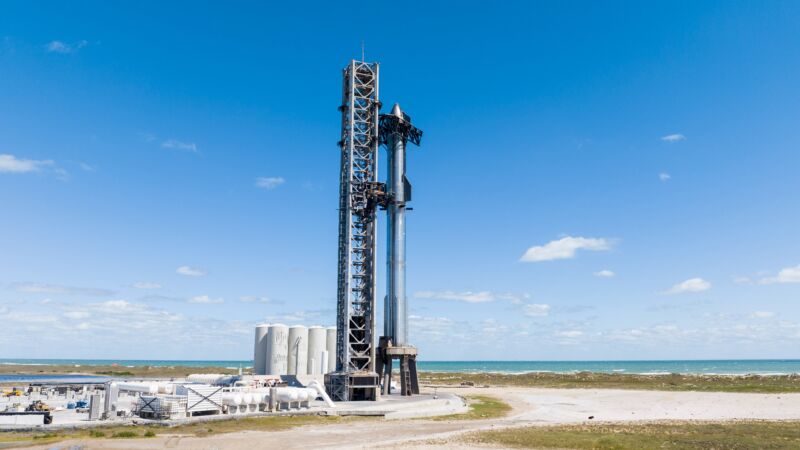
SpaceX announced on Friday that the company is targeting "mid-November" for the second flight test of the Super Heavy rocket and its Starship upper stage.
The company said the launch date is pending regulatory approval, which means that the Federal Aviation Administration and US Fish and Wildlife Service have yet to complete the environmental review process for the rocket and its launch site, which is surrounded by wetlands in South Texas.
Even so, the SpaceX announcement indicates that the company believes it may soon receive this regulatory approval. This is consistent with what sources have told Ars—that federal approval for the second launch of Starship is close to wrapping up.
First flight, not the best
The first full stack of Starship, including its Super Heavy booster, lifted off from South Texas on April 20, 2023. The rocket launched despite three of its 33 main Raptor engines not fully igniting at liftoff. Three more engines failed during ascent, and after a couple of minutes, the vehicle was ultimately destroyed by its flight termination system as it veered off course. SpaceX nonetheless obtained valuable data.
There were issues not just with the rocket but with the launch site as well. The company built its first launch tower without a flame diverter and other structures to help mitigate the power of the 33 main engines. As a result, there was significant damage to the launch pad, and the energy of the launch ejected concrete into the surrounding wetlands.
In the months since, with its characteristic rapid pace, SpaceX has completely rebuilt the launch pad and instituted a water sound suppression system to dampen the energy of liftoff. Part of the review by the Fish and Wildlife Service is to ensure that these measures will adequately mitigate the explosive power of the rocket's ignition and departure from the launch site.
Coming in hot
SpaceX will again target a morning liftoff for the rocket, perhaps around 8 am local time in South Texas (14:00 UTC). Sources have indicated to Ars that the earliest possible launch date is November 13, but nothing is set in stone.
The flight timeline and profile released by the company on Friday for the second flight test is similar to April's test, calling for a 90-minute flight of the Starship upper stage, which is intended to nearly complete a full orbit before splashing down into the Pacific Ocean near the island of Kauai.
One notable change is the addition of a "hot staging" ring between the Super Heavy booster and the Starship upper stage. This technique will call for the Starship's Raptor engines to ignite before the upper stage separates from the Super Heavy first stage. This is more technically challenging than waiting for stage separation, but will eventually result in a higher payload-to-orbit capability for Starship.
“Obviously, that results in kind of blasting the booster, so you've got to protect the top of the boost stage from getting incinerated by the upper stage engines,” SpaceX founder Elon Musk said earlier this year, adding that the design change would add a roughly 10 percent improvement to the Starship rocket’s payload capacity.
SpaceX will not seek to recover either the first or second stage on this flight. The goal, instead, is to prove the flight capabilities of the Super Heavy rocket and, if the stack reaches separation, the performance of Starship. Musk has said he thinks there is about a 60 percent chance that Starship will reach its destination on this flight.
It will be quite a show, regardless.
Reader Comments (270)
View comments on forumLoading comments...